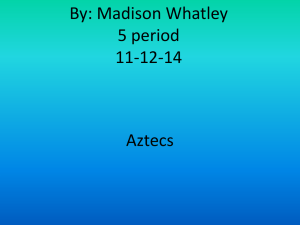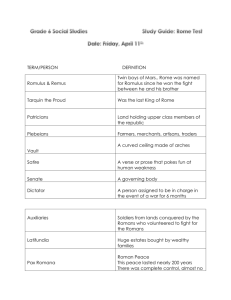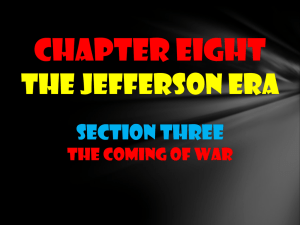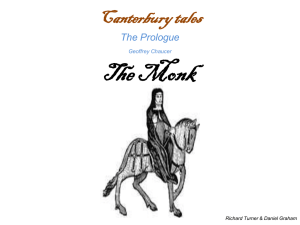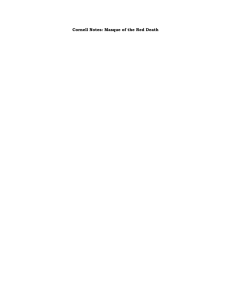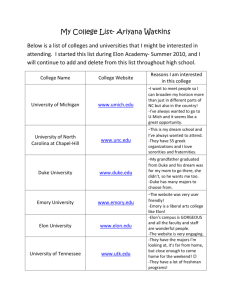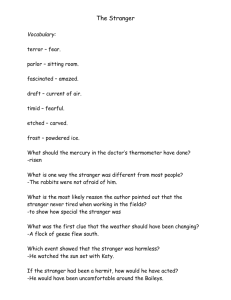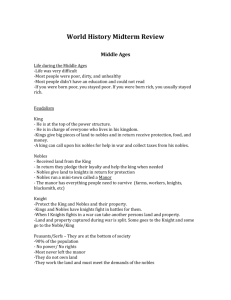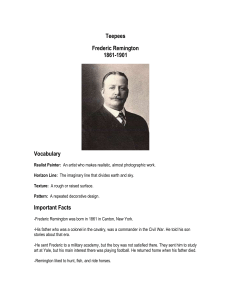midterm review sheet
advertisement
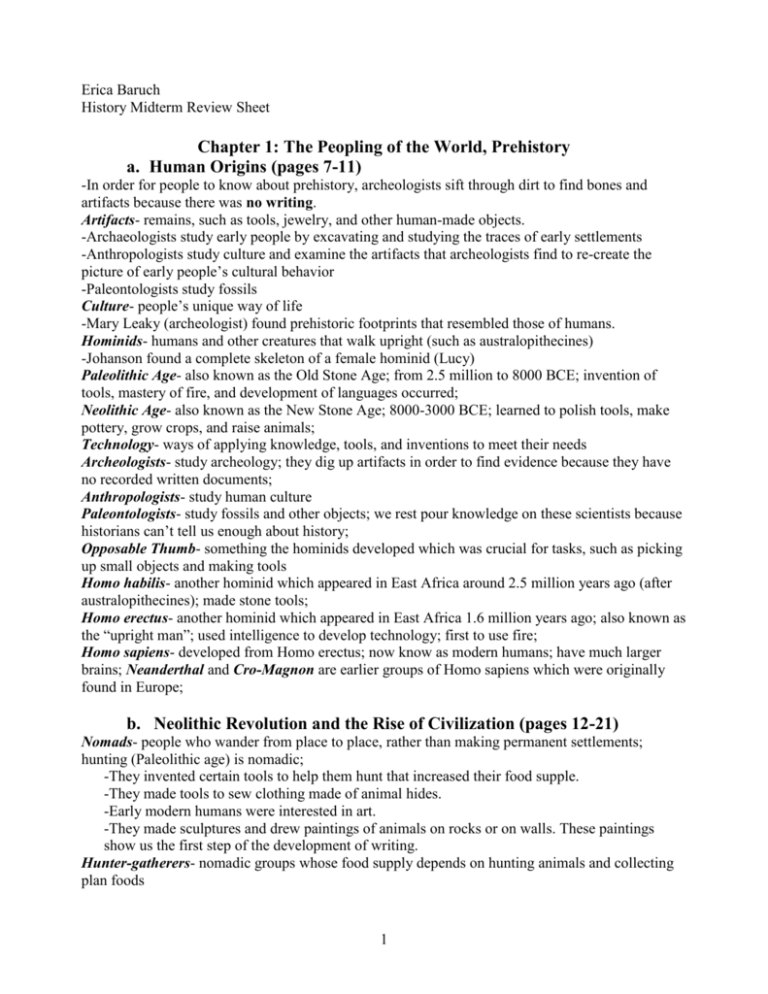
Erica Baruch History Midterm Review Sheet Chapter 1: The Peopling of the World, Prehistory a. Human Origins (pages 7-11) -In order for people to know about prehistory, archeologists sift through dirt to find bones and artifacts because there was no writing. Artifacts- remains, such as tools, jewelry, and other human-made objects. -Archaeologists study early people by excavating and studying the traces of early settlements -Anthropologists study culture and examine the artifacts that archeologists find to re-create the picture of early people’s cultural behavior -Paleontologists study fossils Culture- people’s unique way of life -Mary Leaky (archeologist) found prehistoric footprints that resembled those of humans. Hominids- humans and other creatures that walk upright (such as australopithecines) -Johanson found a complete skeleton of a female hominid (Lucy) Paleolithic Age- also known as the Old Stone Age; from 2.5 million to 8000 BCE; invention of tools, mastery of fire, and development of languages occurred; Neolithic Age- also known as the New Stone Age; 8000-3000 BCE; learned to polish tools, make pottery, grow crops, and raise animals; Technology- ways of applying knowledge, tools, and inventions to meet their needs Archeologists- study archeology; they dig up artifacts in order to find evidence because they have no recorded written documents; Anthropologists- study human culture Paleontologists- study fossils and other objects; we rest pour knowledge on these scientists because historians can’t tell us enough about history; Opposable Thumb- something the hominids developed which was crucial for tasks, such as picking up small objects and making tools Homo habilis- another hominid which appeared in East Africa around 2.5 million years ago (after australopithecines); made stone tools; Homo erectus- another hominid which appeared in East Africa 1.6 million years ago; also known as the “upright man”; used intelligence to develop technology; first to use fire; Homo sapiens- developed from Homo erectus; now know as modern humans; have much larger brains; Neanderthal and Cro-Magnon are earlier groups of Homo sapiens which were originally found in Europe; b. Neolithic Revolution and the Rise of Civilization (pages 12-21) Nomads- people who wander from place to place, rather than making permanent settlements; hunting (Paleolithic age) is nomadic; -They invented certain tools to help them hunt that increased their food supple. -They made tools to sew clothing made of animal hides. -Early modern humans were interested in art. -They made sculptures and drew paintings of animals on rocks or on walls. These paintings show us the first step of the development of writing. Hunter-gatherers- nomadic groups whose food supply depends on hunting animals and collecting plan foods 1 Neolithic Revolution- agricultural revolution; major change in human life resulting from the beginnings of farming (crops) Slash-and-burn farming- type of farming method in which you cut trees or grasses and burned them to clear a field and then the remaining ashes fertilized the soil Domestication- taming of animals (hunters’ expert knowledge of wild animals played a key role) -Farming developed in various places: Africa, China, Mexico, Central America, and Peru. -Drawbacks of villagers: floods, fire, drought, and natural disasters Diseases spread easily because they lived close together Nomads might attack them for loot -Settlements were more popular because: domesticated animals were common, there were tools that made farming easier, and they were getting better at controlling their natural environments. -Economic Changes: since were getting good at farming there was surplus they didn’t need as many farmers people got other jobs specialization in jobs (craftspeople and traders) -Social Changes: they had class systems -Religious Changes: the Gods of nature are now rain and wind Civilization- a complex culture with five key aspects: -Advanced cities- a city is a center of trade for a larger area -Specialized workers- traders, government, priests Artisan= skilled worker who made goods by hand (jewelry/weapons) Specialization= development of skills in a certain kind of work -Complex institutions- government, religion, economy Temple= center of community (government and economic affairs there) Institution= long lasting pattern of organization in a community (government) -Record keeping- scribes= record keepers Cuneiform= system of writing -Advanced technology- Bronze Age= the time when they began using bronze (rather than copper and stone) to fashion tools and weapons Barter= trading without money (trading with skills) Ziggurat= massive tiered structure that towers over the city inside the temple gate **Early civilizations settled along river valleys for defense, irrigation, transportation, and silt from bottom of river fertilizes soil **Government started in order to maintain order among people and establish laws; it also arose in order to deal with irrigation. Villages Grow and Prosper: Catal Huyuk, an agricultural village in Turkey were part of a settled life. Farmers made wheat barley, and peas. Villagers also raised sheep and cattle. Potters and weavers worked there too. They made obsidian products to make mirrors, jewelry, and knives for trade. They also had certain religious beliefs. Problems with village: fire, floods, jealous neighbors, and diseases Sumer: -In 3000 BC, Sumerian scribes invented cuneiform. -They wrote about their city’s dramatic events, wars, natural disasters, and the reign of kings. 2 -Advanced Technology: 3500 BC, Sumerian artisans invented the potter’s wheel Civilizations in UR: -UR was one of the earliest cities in Sumer. People lived in well-defined social classes. Priests and rulers wielded great power. Wealthy merchants profited from foreign trade. Artists and artisans created many beautiful works. They made musical instruments, gold helmets, and daggers. -They made a large scale irrigation system to provide Ur with food surpluses. They made ditches carry water into their fields form a reservoir. -People lived in one small house except for the wealthy people who had a courtyard and live in two story houses. Chapter 2: Early River Valley Civilizations - Mesopotamia and Egypt a. Mesopotamia and Hammurabi’s Code (pages 27-32) Fertile Crescent- area between the Persian Gulf and Mediterranean Sea in Southwest Asia that provides some of the best farming Mesopotamia- “land between the rivers” It lies between the Tigris and Euphrates rivers. People began to settle this land around 4500 B.C. It wasn’t until 3500 B.C. that the Sumerians arrived. Tigris and Euphrates- They are two rivers that flow southward to the Persian Gulf. Located on the sides of Mesopotamia. These two rivers flood Mesopotamia at least once a year, but flooding was unpredictable. 3 issues that the Sumerians faced with their land: 1) The flooding of the river was unpredictable and sometimes it flooded too much Solution: irrigation (ditches that brought the water to the fields) 2) Sumer was a small region with little grass huts and no natural protection, so they were defenseless against any possible invasion. Solution: they used mud-dried bricks to build surrounding walls 3) The natural resources of Sumer were limited, and without a good supply of wood, metal, and stone, they didn’t have a lot for tool making Solution: They traded with the mountain people and dessert people for the tools they needed City-State- A city and its surrounding lands functioning as an independent political unit. Although they shared the same culture, they developed into their own governments. Silt- a thick bed of mud left behind after the floodwater from the 2 rivers Dynasty- a series of rulers in one family (type of government in which in which rulers passed their power on to their sons who eventually passed it on to their own heirs) -At first the priests were in charge, but in times of war one man would take charge and then there would be a dynasty Cultural Diffusion- the process of new ideas or products spreading from one culture to another Polytheism- the belief in many gods (Sumerians were polytheistic) Sumerian Culture: Social classes slowly arrived. Priests and Kings wealthy merchants workers (farmers and workshop people) slaves (if they worked very hard, they could be freed) Even though women may not have been allowed to attend schools with upper-class boys, the Sumerian women had more rights than women in many later civilizations. First Empire in the World-Akkadian Empire: -Akkadians were a Semitic people (unlike Sumerians) 3 *Semites spoke something related to Hebrew and Arabic -Sargon was a conqueror in about 2350 B.C. who took over Mesopotamia -It lasted about 200 years and ended because of internal fighting, invasions, and famine. Empire=bringing together of several people, nations, and previously independent states and putting them under one ruler—central government *How do you become part of an empire: inheritance, surrender, war, and peace treaty *How did empire help: more tradecultural diffusion and better defense Babylonian Empire: -In 2000 B.C. the Amorites (Semitic nomadic warriors) invaded Mesopotamia and made Babylon its capital Hammurabi- a Babylonian king who reigned from 1792-1750 BCE Hammurabi Code of Laws- a published a code of 282 laws for the whole empire **The punishments varied depending on social status. b. Egypt (pages 33-39) Cataract- when jagged cliffs and boulders turn the river into churning rapids -The lower part of the Nile ended at a cataract -Lower Egypt consisted of the Nile Delta region until the Mediterranean -Upper Egypt consisted of a skinny strip of land from the cataract to the point where the river branches out into many different parts -The deserts on both sides of the Nile were natural barriers so the Egyptians had to stay close to the river, isolating them from other peoples (they were spared the constant warfare) -3200-2000 B.C. Egyptians began traveling to Mesopotamia (and later other places) to trade. They specifically wanted materials to build their temples. Menes- a king of Upper Egypt who united all of Egypt and created a dual crown to unite them -The kings of Upper Egypt wore a tall white crown (like a bowling pin) and the king of Lower Egypt wore a red crown. -He started the first dynasty in Egypt. Pharaoh- the name of the Egyptian god-kings Re—Horus (king)—becomes Osiris when he dies—ka=soul’s double when he dies Mummification- way the Egyptians preserved a dead body by embalming and drying the corpse to prevent it from decaying -Pharaohs are mummified and buried in pyramids that act as his palace when he rules from the afterlife (the Old Kingdom was famous for their pyramids). -Death: the Egyptians believed in afterlife. After you died you would be judged (your heart would be weighed) and if it is heavier than a feather then the Devourer of Souls would gobble up the impure heart, but if the heart passed then you went on to live life in the Other World. You were buried with things that you would need in the afterlife like clothing, food, cosmetics, scrolls, prayers, and magical spells. Pyramid- an immense structure used for the resting place after death for the kings of the Old Kingdom Ma’at- things work out exactly the way they are supposed to (life is perfect) Theocracy- type of government in which the ruler is a divine figure: the pharaoh stands at the center of Egypt’s religion as well as its government and army Hieroglyphics- the Egyptian writing that had pictures that stood for an idea Papyrus- reeds that grew in the marshy delta 4 Mesopotamia Egypt No good defense Natural barrier Rivers unpredictable Nile is predictable (July) Few natural resources Abundant natural resources Pessimistic Looked forward to afterlife Kings represent gods Kings ARE gods Both Polytheistic Pros of the Nile The Nile flooded every July so the farmers were very well prepared. They used irrigation and were well organized. Risks of the Nile -If the Nile flooded too little the planted crops would die no food If the Nile flooded too much the extra water would destroy the planted crops. Egyptian Classes of Society: King, Queen and Royal Family Upper Class: Wealthy landowners, government officials, priests, and army commanders Middle Class: Merchants and artisans Lower Class: peasant farmers and unskilled laborers (largest class) -Slavery eventually became a widely used source of labor and slaves were usually captives of foreign countries from wars -Social classes were not permanent. One could climb the ladder by marriage, success in their jobs, gaining freedom, learning how to read and write or other skills that could gain them high jobs. -Women had the same rights as men. They could own and trade property and she could gain 1/3 of her and her husbands’ land by seeking divorce. Egyptian Sciences: -Medicine partly consisted of magic and charms. They also used practical knowledge like feeling a person’s heart rate in different parts of the body, splints for broken bones, effective treatments for wounds and fevers, and occasionally used surgery to fix some conditions. -The farmers needed math to make calculations and measurements -They developed a system of written numbers for counting, adding, and subtraction that they used for taxes and as geometry for predicting the Nile. They also used it for architecture (pyramids) -They made a calendar that was only off the true solar year by 6 hours. Old Kingdom to Middle Kingdom: -The Old Kingdom ended in 2180 B.C. -Strong pharaohs regained control in the short Middle Kingdom (2080-1640) but it ended because the Hyksos took over in 1640 until 1570 B.C. 5 Chapter 4: The First Age of Empires a. The Empires of Egypt and Nubia Collide (pages 83-85) Hyksos- invaders (nomads) who ruled Egypt after the Middle Kingdom ended. They used chariots to take over (the Egyptians didn’t know how to respond to chariots) -Warlike rulers drove the Hkysos out of Egypt New Kingdom- Egypt became an empire after throwing the Hyksos out (third period of glory). -They went out to conquer other people once they had power over themselves. -They added a new crown to the one Menes made – a blue one in the shape of a battle helmet. Hatshepsut- female pharaoh of new kingdom -She took over because her stepson was too young to take over -She was unique because she promoted trade and domestic issue rather than war and foreign affairs. Thutmose III- Hatshepsut’s stepson -He was more of a warlike ruler. **He may have murdered his stepmother because of his eagerness to take the throne -He invaded Palestine and Syria Nubia- a region of Africa (straddled the upper Nile River) that Thutmose III invaded Ramses II- a pharaoh who made a treaty with a Hittite king (they were fighting with the Hittites) -The Hittites and the Egyptian Empire were attacked by the sea people (also Libyans) Kush- Nubian Kingdom -After Egypt occupied this kingdom for a while, Egypt fell into decline and Kush emerged as a regional power and established its own Kushite dynasty on the throne of Egypt Piankhi- Kushite King who overthrew the Libyan dynasty that had ruled over Egypt for 200 years b. Assyria Dominates the Fertile Crescent (pages 88-91) Assyria- in 850 BCE it acquired a large empire -They had sophisticated military organization and state-of-the-art weaponry -They conquered with uniforms of leather and metal/iron, iron weapons, advanced and skilled planning dug beneath the city’s walls to weaken, trained soldiers (some went on foot while others attacked the gates) -They showed no mercy when they enteredthey killed and enslaved everyone and forced them out of their homes to provinces and dependent states to prevent uprisings **They were very devoted to their army and were not very tolerant -Assyria defeated Syria, Palestine, and Babylonia, all the way to North Africa Militarism- basis of your culture is your military Assyria relied heavily on its military and also glorified it Sennacherib- Assyrian King who bragged about how many people he killed and villages he sacked -Assyria chose the kings and leaders for dependent lands in order to collect taxes and tributes (if someone did not pay the tax, that city would be destroyed and its people would be sent into exile) Nineveh- Assyria’s capital located along the Tigris River -It had one of the largest ancient libraries Ashurbanipal- Assyrian King -He prided himself on his ability to read in several languages -He was the last of the mighty kings of Assyria after he died Nineveh fell -In 612 BCE a combined army of Medes, Chaldeans, and others burnt Nineveh Nebuchadnezzar- Chaldean/Babylonian King who restored Babylon (capital for Chaldeans) -He made the hanging gardens for his wife 6 -The walls of his capital were extremely thick and he had a huge ziggurat that was 300 feet high Autonomy- self-rule even though the Assyrians were being ruled in an empire and had to obey a king, they still had some independence as long as they didn’t conflict with the higher power and they did what they were supposed to do. c. Persia Unites Many Lands (pages 92-96) Indo-European- a family of languages consisting of most of the languages of Europe as well as those of Iran, the Indian subcontinent, and other parts of Asia -The Medes overthrew the Assyrian Empire Cyrus- King of Persia -He and his armies conquered the entire Fertile Crescent and most of Anatolia -He was incredibly tolerant to conquered people **He would pray to the Gods of his conquered people when he conquered them -His army was organized and well equipped -Cyrus allowed the Jews who were exiled by the Babylonians to return to Jerusalem in 538 B.C. where they rebuilt their city and temple. The Jews were very grateful to Cyrus. Cambyses- Cyrus’ son -He extended the Persian Empire by conquering Egypt, however he did not follow his father’s example, instead he publicly scorned the Egyptian religion -After he died there were many revolts Darius- Cambyses’ successor who took over after he died -He had to put down the revolts -His only failure was his inability to conquer Greece -He made coins (like the Lydians) that promoted trade -He divided the empire into 20 provinces that were all allowed to practice their own religions, speak their own languages, and followed many of their own laws. Royal Road- a famous road that ran throughout the Persian Empire that road enabled empires to expand and maintain control over people and places (also promoted trade) Satrap- a governor who ruled in each province of the empire (King’s Eyes and Ears) Zoroaster- a Persian prophet and religious performer who lived around 600 BCE; he answered the question of ‘Why should so much suffering and chaos exist in the world?’ Semitic- refers to a family of languages (Hebrew/Arabic) or any people who speak those languages. Chapter 5: Greece Geogrophy: -Used to be made up of separate lands where Greek-speaking people live and mainly consisted of mountainous peninsular jutting out from the Mediterranean Sea (and other islands) -They needed trade because didn’t have very much of natural resources -They developed little communities because it was too hard to unite all of it under one government -Its uneven land made it hard to travel -Only 20% of the land was suitable for farming so diet was based on staple crops, grapes, and olives -They had good temperature that supported outdoor life and outdoor public events The Myceneans- settled in Greece around 2000 B.C. Mycenae: -Located on a steep, rocky ridge and surrounded by a protective wall that withstood attacks -Used bronze weapons 7 -They had jobs of laborers: (tools made of stone and wood) farmers, weavers, goat-herders and stonemasons Trojan War- Mycenaeans fought a ten-year war against Troy (an independent trading city) because the Trojan youth had kidnapped Helen (the beautiful wife of a Greek king). -Short after this war the Mycenaean civilization collapsed because sea raiders attacked and burned each and every palace. Dorians: -Moved into what was the Mycenaeans’ land -Spoke a dialect of Greek -They were distant relatives of the Bronze Age Greeks -They were less advanced than the Mycenaeans -Their economy collapsed and trade eventually became frozen with their arrival -They didn’t know how to write so little records so don’t know much about them Dorain Age was a period of decline Homer- a blind storyteller of the Greeks who composed epics **He wrote The Iliad (Greek Achilles and Hector of Troy) and the The Odyssey (adventures of Odysseus who defeats the Trojans after the war) -He spent ten years on a journey to get home because he was blind -Myths=traditional stories about Greek gods that explained how the Greeks sought to understand nature and power of human passions. Their gods lived forever: Zeus (ruler of the gods) lived on Mt. Olympus with his wife Hera, and his daughter was Athena. Polis- Greek city-state made up of city and surrounding countryside Acropolis- public center on hilltop, where male citizens went to do business Monarchy- kings/ monarchs ruled in a government Aristocracy- government ruled by a small group of noble and landowning families, Oligarchy- government ruled by a few powerful people, representative government Iron- started to replace bronze in making spears, shields, breastplates, and chariots because it was more common and cheaper Regular citizens could defend themselves with arms, and rebel against the more powerful people Phalanx- fearsome formation of foot soldiers (called hoplites) who held spears and shields while standing side by side, most powerful fighting force in ancient world. Tyrant- powerful individuals who gained power by appealing to the poor for support to take over ∞ two most powerful cities were Sparta and Athens who found new ways of governing (not tyrants) SPARTA: -Located in the Peloponnesus peninsula -They built a military state -They conquered Messenia around 750 B.C. -Government: Assembly=free adult males who elected officials and voted on major issues Council of Elders=proposed laws that the assembly voted on 5 elected officials (ephors) carried out the laws, controlled education, and prosecuted court cases 2 kings who ruled over military -Their population consisted of several social groups and was very diverse -Classes: Original Greeks (who had been in the area for a long time) could rule and own land Free non-citizens worked in commerce and industry Helots (a little higher than slaves) Slaves 8 -Men=daily training for military (at age seven boys left home and moved into army barracks) -Girls ran and wrestled and played sports **Like boys they put their love for Sparta above love for family -Women took care of family estates while men were out, women did not have right to vote but took bigger part in society than most other Greek city-states -They did not value arts -They valued duty, strength, discipline over individuality, beauty, and freedom. Helots- (slaves) Messenian peasants that were forced to stay on the land they worked -Spartans demanded half their crops every year -The Messenians (outnumbered the Spartans) revolted and Sparta barely won ATHENS: Democracy- government ruled by the people -Citizens (male men) participated in political decision-making -Slaves were 1/3 of Athenian population and they worked in mines, slaves farmed fields, and did the housework -Women cared for the children, wove cloth, prepared the meals, managed the household, and had very little to do with the city’s intellectual life ∞ uprisings occurred between aristocrats and common people ∞ people demanded written law code, in 621 B.C.- first Greek written legal code by Draco, code dealt with mainly contracts and property ownership. Cylon- a nobleman who tried to establish a tyranny -They wanted a law code so Draco wrote one but it wasn’t fair Solon: -The aristocrats chose him to prevent a civil war (because of the law code) and reform the law -He outlawed debt slavery and allowed all citizens to participate and debate polices -He made laws the allowed anyone to charge wrongdoers -He initiated profited overseas trade **He neglected land reforms so at end of his rule wealthy and poor landowners began to fight Pisistratus- the first tyrant over Athens -He provided money for peasants to buy farm equipment but he financed this reform by taxing on agricultural production -He launched massive building program that gave jobs to the poor to get their support Cliesthenes- Athenian leader who worked to break up the power of the nobility -He allowed all citizens to submit laws for debate and passage -He created the Council of Five Hundred Council of Five Hundred- council that proposed laws and counseled the assembly -Its members were chosen randomly -The reforms allowed Athenian citizens to participate in the limited democracy but only 1/5 of its society b was citizens PERSIAN WARS: -Began in Ionia on the coast of Anatolia -Between Greece and the Persian Empire -Greeks were there long before the Persians came and conquered the area -Athens sent aid when Ionian Greeks revolted -Darius destroyed the Ionian Greeks’ rebellion and promised to destroy Athens for sending aid -In 490 B.C. a Persian ship was sent to Marathon (in Athens) but the Athenians awaited their arrival in phalanxes Athens won but now stood without any defense 9 Pheidippides- a young runner who they sent back to Athens to tell them that they won so they wouldn’t let their city go down, and once he delivered his message he died. -The Greek army was then ready for the Persian ships that sailed in to the harbor and once they saw the Greeks, they retreated Xerxes- comes to power in 480 B.C. when his father Darius dies -He sent an enormous invasion of ships and men into Greece when Greece was not united -Some of the Greek city-states fought, others wanted to let Athens fight and loose, and some even fought WITH the Persians -He marched down the eastern coast of Greece where he was blocked at Thermopylae -They fought for 3 days until a traitor told the Persians about a secret path behind cliffs Spartans went to defend the path and made a great impression on all Greeks (they all died) Salamis-Themistocles (Athenian statesman) convinced Athens to use navy in order to fight the Persians -Persia set fire to Athens while they were at sea and then brought their fleets to either end of the channel but had trouble maneuvering there -The Greeks drove their battering rams into Persian wooden ships that made holes 1/3 of the Persian fleet sunk -The rest of the Persians were defeated by the Spartan at a 3rd battle at the Plataea plain in 469 B.C. Delian League- 140 states unified to protect against future attacks that was formed as a result of the Persian defeat -Athens became the leader and used its navy to control the other states (lead to their Gold Age) Pericles- lead Athens during the Golden age and was popular for 32 years -3 goals: 1. Strengthen Democracy: Pericles used paid public officials because before only the rich could be in the government because it didn’t pay, but now poor people had the same chance -Direct Democracy=government where citizens rule directly (not through representatives). 2. Strengthen the Empire: Pericles wanted to make the empire wealthier and more powerful. He made a 200-ship navy that made the empire safer (money from the Delian League) 3. Glorify Athens: Pericles used money from the Delian League to buy gold, ivory, and marble in order to beautify Athens. -Parthenon=building to honor Athena that was worked on for 15 years (money from Delian League) Art: -Created figures that were strong, graceful, and perfectly formed because they valued order, balance, and proportion -Sculptures faces showed serenity and tried to capture the ideal human body in motion DRAMA: -Expression of civic pride and tribute to the gods -They used colorful costumes, masks, and sets and the money was provided by the wealthy people -The plays were about leadership, justice, and the duties of the gods Tragedies-Serious drama about love, hate, war or betrayal that had main a character or hero who had special abilities and his error caused his downfall (usually something about their humongous ego) -Aeschylus wrote 80 plays his most famous was The Oresteia (Agamemnon in the war at Troy) -Sophocles wrote 100 plays including Antigone and Oepidus the King -Euripides wrote Medea Comedies-Crude humor and satires that made fun of customs, politics, people, or ideas -Aristophanes wrote the first great comedy called The Birds and Lysistria 10 Peloponnesian War: -Sparta declared war against Athens in 431 B.C. -Athens had the stronger navy but Sparta was inland so it was hard to attack them by sea -Pericles wanted to attack allies of Sparta coming on water before attacking the actual Spartans -Spartans marched into Athens burning their food supply but Athens brought the people of their countryside inside the city’s walls -In the second year of war, a plague hit the Athenians and between one and two thirds of its citizens died including Pericles -The Athenians sent 27,000 soldiers to destroy the polis of Syracuse (a wealthy ally of Sparta) but they were defeated in 413 B.C. -Athens fended off Spartans for another nine years but then in 404 B.C. surrendered Athens suffered the loss of a democratic government and did not stick to one political program (they continued to have one leader after another) PHILOSOPHERS: -“Lovers of wisdom” who sought the truth based on the two assumptions: universe (land, sky and sea) was put together in an orderly way and needed unchanging laws and these laws should be able to be understood by the people with logic and reason Socrates- didn’t believed in standards for truth and justice and he encouraged questioning of ones moral character -The majority of citizens did not understand him but those who did admired him -In 399 B.C. he was brought to trial for corrupting education of children and neglecting the gods -He died by drinking slow-acting poison Plato- student of Socrates -He wrote The Republic – vision of a perfectly governed society that was not a democracy 3 kinds of groups: farmers and artisans, warriors, and the rulers, ruler would be philosopher-king -His writing were very prominent in philosophy of Europe for 1500 years Aristotle- student of Plato who questioned the nature of the world and of human belief, thought, and knowledge -He almost summarized all the knowledge of his time and he invented a way of arguing logically -He applied his method to psychology, physics and biology and it was the basis for the scientific method that we use today Macedonia- rough mountains, cold climate -They lived in mountain villages (not city-states) and spoke like Greeks -The nobles considered themselves Greeks but the Greeks themselves considered them to be uncultured foreigners (with no great philosophers, sculptors, or writers) Philip II- in 359 B.C. became king at the age of 23 -He was a brilliant general and politician -He created a strong army with double the size phalanxes with 18 foot pikes, cavalry followed to crush the disoriented opponents **His army soon proved to be unbeatable so he wanted to invade Greece but a guard at his daughter’s wedding stabbed him. Demosthenes- Athenian orator who opposed Philip II and urged uprisings against him -In 338 B.C., Athens and Thebes got ready to rise up against Philip but were too late because the Greeks had been defeated by Philip at the battle of Chaeronea Greeks no longer had freedom or independence and the city-states were still self-governed but under the rule of foreign kings 11 Alexander the Great- son of Philip II -He became king at age 20 because of his father’s death (336 B.C.) -He learned science, geography, and literature from Aristotle -He learned to ride a horse, use weapons, and command troops -Thebes (Greek city) rose up against Alexander (thought it was a good time because he was young and father was dead) but Alexander showed his military strength by crushing them and destroying their city and sent them into slavery (no other cities afterwards rebelled) -He wanted to follow his father’s dream of invading Persia so in 334 B.C. he invaded Anatolia -40,000 Persian men were sent to meet them at the Grancius River -Alexander attacked first with his cavalry and crushed the Persians -Darius III was the Persian king at the time and he wanted to crush the Macedonians so he sent many men near Issus -Macedonians were greatly outnumbered but Alexander sent his best troops through a weak spot in Persian lines and aimed straight for Darius III who quickly fled along with his army Alexander got control of Anatolia -Darius III offered the western part of the empire to Alexander as a peace settlement but Alexander refused because he wanted ALL of the Persian Empire -He invaded Egypt in 332 B.C. and was crowned pharaoh -He founded city of Alexandria near the Nile -After leaving Egypt, Alexander confronted 250,000 Persian men at Gaugamela and he charged at them with phalanxes followed by cavalry Darius III fled and Persia lost its power -Eventually Alexander’s army was in Babylon, Susa, and Persepolis -Alexander followed the Darius and when he got to south of the Caspian Sea, Darius III was already dead (killed by governors) -Alexander continued going east towards Central Asia, trying to reach the edge of the continent -In 323 B.C. he returned to Babylon to unify his empire and conquer Arabia but one year after returning, he died at age 33 He left empire to strongest general: Antigonus who took control of the Greek city-states Ptolemy- took over Egypt and became pharaoh (had a dynasty) Seluecus- took over most of Persian Empire and created the Seleucid Empire Hellonistic Culture- mix of Greek culture and elements of Egyptian, Persian, and Indian -Use of the language of koine in Alexandria was a symbol of the cultural blending and it helped people from different areas to communicate *Koine=Greek word for common Alexandria- leading city of commerce in Hellenistic world -It was on the edge of the Nile so it was very good for trade -Warehouses there were overstocked with products from the Nile Valley -By 3000 B.C. Alexandria had population of 500,000 including Egyptians, Greeks, Jews, Indians, Africans, and Persians the international community had a mix of customs and traditions -The blocks of Alexandria were wide and filled with statues of the Greek gods and rulers built beautiful palaces -Alexander’s glass tomb lay there -There was an enormous lighthouse that was 400 feet high with light burning at the top and a mirror that reflected it overlooked the harbor Aristarchus- concluded that sun was at least 300x size of earth (disproved others before him who thought sun was smaller than Greece) and that the earth and other planets revolved around the sun Eratosthenese- almost exactly calculated earth’s actual size (astronomer) 12 -He was the director of the Alexandrian library and also a poet, historian, and mathematician Euclid- a highly regarded mathematician who opened a geometry school in Alexandria -He wrote the Elements, which contained 465 geometry propositions and proofs Archimedes- studied in Alexandria and accurately estimated value of pi -He explained the law of the lever -He invented a compound pulley to lift heavy objects, the Archimedes screw which raised water from the ground, and a catapult (missile- throwing machine) -Because of his knowledge other scientists were able to build a force pump, pneumatic machine, and a steam engine Zeno- started a school of philosophy called Stoicism that believed in a divine power controlling the universe and proposed that people should live life in harmony and keep the law -He believed in controlling human desires like wealth and power and to focus on things that they could control themselves **This school of thought appealed to many different raves, cultures, and economic backgrounds Epicures- founded school of thought called Epicurism and taught that universe was made up of atoms and ruled by gods who had no interest in humans -According to his teachings the main goal of humans was to achieve harmony of body and mind -He encouraged moderation of all things Colossus of Rhodes- bronze statue, more than 100 feet tall **One of the seven wonders of the ancient world but was toppled by an earthquake in 225 B.C. Winged Victory- commemorates victory of Greece -Hellenistic sculptures moved from being all about harmony and balance into more realistic and emotional pieces (more natural) In 150 B.C. Hellenistic world went into decline as Rome began to rise DECLINE- somewhat caused because the last of the Five Good Emperors, Marcus Aurelius, didn’t know how to deal with the problems facing the empire Economic: -Trade: hostile tribes and pirates interrupted trade -All of the money was spent on wars and luxuries that lead to the draining of gold and silver **The empire no longer expanded so there were no new sources of these precious metals -Inflation: they raised taxes and started minting cheaper coins with less silver -Agriculture: the soil was overworked so it lost its fertility and farmland was destroyed by war -Farmers had to leave their land because of taxes -Cheap slave labor no improvements in technology -Food shortages and disease spread population decline Military: -3rd century: Germanic tribes overwhelmed the Roman soldiers guarding the northern frontiers -Persia threatened Roman territory in Syria and Anatolia -Anyone who wasn’t roman or was an invader was called a ‘barbarian’ -Most embarrassing defeat was when Persia captured emperor Valerian -The loyalty and discipline in the army declined it transferred from Rome to commanders who fought for the throne -They recruited mercenaries (foreign soldiers) who fought for the money (accepted lower pay than Roman soldiers) **Mercenaries had no loyalty towards Rome because they did it for money not to protect Rome (no patriotism) 13 Government: -The citizens lost sense of patriotism/ loyalty to the republic -The government positions used to be desired and honored but in the 2nd century they had to pay for the circuses and baths out of their own money not many wanted to serve -The soldiers were the only ones who stayed interested in politics -For a 50 year period, 50 generals ruled as emperors (26 won brief approval of senate, 25 died) Diocletian- became emperor and restored the empire (increased its strength) -He governed as an absolute ruler and limited personal freedoms -He doubled size of Roman armies by drafting prisoners and hiring German mercenaries -He attempted to control inflation by setting fixed prices for things -He ordered farmers and works to remain on their land and work it for life -He was anti- Christianity, persecuted Christians, and claimed to have descended for Roman gods -He split the empire into 2 because it was too hard for one ruler to rule alone: Greek-speaking East and Latin-speaking West -He ruled the eastern half because it was wealthier and had the more important cities -General Miaximian ruled the western half -The authority was shared but Diocletian kept overall control **His reforms slowed decline of the empire because the boarders became safe again and emperor’s prestige was restored, but he only made temporary solutions -After he retired civil war broke out (3 rulers competed for power) Constantine- gained control of the western part of the empire in 312 A.D. -He continued social and economic policies of Diocletian -In 324 A.D. he secured the control of the East and reinstated the concept of a single ruler -In 330 A.D. he moved the capital from Rome to Byzantium (located strategically in a good place for trade and defense and was also at a crossroads of the Eastern and Western parts of the empire) and called it Constantinople The power now shifted from Rome to the East -The capital was protected by massive walls and filled with imperial buildings -After Constantine’s death, the empire became divided again where the East was able to stand but not the West Invaders: -The final collapse of Roman Empire was caused by internal problems, separation among the empires, and outside invasions -Since Julius Caesar, Germans had been bothering the northern side of the empire -From 376-476 huge numbers of Germans poured into Roman territory and eventually they overwhelmed Roman society - drove the last emperor from his throne Huns- fierce Mongol nomads (from Central Asia) who pushed other groups into the Roman Empire -They were the main reason of Germanic invasions of Europe -They invaded frontier regions of Rhine and Danube rivers by destroying everything in their path German Invasions- were caused by the Huns who sought refuge from Huns -They met no resistance as they entered so they kept moving through the empire towards Gaul (Western part of empire had no defense because it was so disorganized) Alaric- king of Visgoths who invaded Rome in 408 -He put city under siege therefore large numbers of Germans stormed though it in 410 and robbed it Attila- 444 Huns united under this chieftain -He had 100,000 soldiers and he terrorized both sides of Roman Empire -He plundered 70 cities in the East but wasn’t able to get through Constantinople 14 -In 452 A.D. advanced towards Rome but were stricken by famine and disease and Pope Leo I was able to persuade them to withdraw -In 453 A.D. Attila died and the Huns were no longer a threat -In 455 A.D. the Vandals sacked Rome (leaving it chaotic) but there was a famine and their population dropped from one million to 20,000 Romulus Agustulus:- last roman emperor (14 years old) -He was overthrown by German general named Odoacer and sent into exile The eastern half of the empire flourished and was called the Byzantine Empire Greco-Roman Culture- a mix of Greek, Hellenistic, and Roman cultures -Roman artists, philosophers, and writers didn’t copy Greek and Hellenistic models but adapted from them and created a style of their own that conveyed Roman strength, permanence, and solidity Arts: -They learned sculpting from the Greeks but made more realistic portraits in stone than the Greeks -The art had a more practical purpose like public education -They developed sculpture type called bas-relief which are images that project from a flat background that represented crowds of people, soldiers in battle, and landscapes -They were skilled in mosaics -Roman villas (wealthy roman homes) had at least one mosaic and murals called frescoes that are painted directly onto the wall (not many have survived) -Pompeii: best examples of Roman paintings are from here that date back to 2nd century B.C. that were preserved by ash from a volcanic eruption Learning and Literature: -They learned philosophy from the Greeks (mainly Stoicism) -Stoicism encouraged virtue, duty, moderation, and endurance -Greek works inspired roman literature -Romans used their own ideas and themes but followed Greek models and forms -Virgil: a poet that wrote most famous wok of Latin literature called Aeneid (like Homer) -Ovid: Roman poet that wrote light and enjoyable poetry; wrote the Amores about love -Livy: composed a multivolume history of Rome from 9 B.C. but he incorporated legends so it isn’t a true history -Tacitus: historian that presented historical facts accurately- he wrote Annals and Histories (about the good and bad of imperial Rome) Latin- remained the language of learning after the empire fell -The official language of the Roman Catholic Church still in 20th century -It was adopted by different peoples and developed into French, Spanish, Portuguese, Italian, and Romanian they are all called the Romance languages because of common Roman language -Influenced other languages such as English Architecture, Engineering, and Technology: -The arch, dome, and concrete were combined to form Roman architecture such as the coliseum -Arches were supported by bridges and aqueducts (brought water into cities and towns) -Many U.S. buildings have ancient Roman influences -Roman roads were also constructed of stone and concrete and sand that connected all parts of the empire (some are still there) Roman Law: -Early Roman law dealt a lot with citizens -As the empire grew, they felt that laws should be fair and equal to all people (rich and poor) -Judges recognized standards of justice that were influence by stoic philosophers -We still use some of their laws in our laws today 15 -Some of the most important laws were: 1. All people had the right to equal treatment under the law 2. A person was considered innocent until proven guilty 3. The burden of proof rested with the accuser rather than the accused 4. A person should be punished only for actions and not thoughts 5. Any law that seems unreasonable or grossly unfair should be put aside -The laws strengthened Western cultural tradition ***Rome’s fall was important to all later civilizations Chapter 10: ISLAM Arabian Peninsula- crossroads of Africa, Europe, and Asia composed of barely fertile lands and mostly desert so its inhibitors were mostly nomadic peoples (Arabs) Bedouins- nomads organized into clans that provided security and support for a life in the desert -They took pride in their ability to adapt to desert and defend against raids by other clans who were in search of water, grazing territory, livestock, or food supplies -Their fighting ability was the core of the armies that would build the empire -Their ideals: courage, family loyalty, and warrior skillsbecame Islamic way of life -Oasis=market town -The areas with more fertile soil and larger oases had enough water to support farming communities -The larger of these oases became places of local, regional, and long-distance trade -The trade routes connected Arabia to the major ocean and other main trade routes and they ran from the Byzantine and Sassanid empires to the north (merchants traveled along these caravan routes trading goods from the Silk Roads from the east) Mecca- a city in western Arabia that was an important stop of the trade route Ka’aba- an ancient shrine in Mecca that contained over 360 idols brought by tribes **Arabs associated it with Abraham (a monotheist) -Over time, it introduced the worship of many gods and spirits and it was considered pilgrimage Allah- Arabic G-d -Hanifs=people who had previously believed in one G-d -Many Jews and Christians lived in the Arab lands and practiced monotheism that lead to the development of a monotheistic Arab religion Muhammad- born into a clan of a powerful Meccan family and was raised by relatives -He worked as caravan trader (took people around trade routes) -He became trader and business manager for Khadijah (a wealthy businesswoman) and married her -He prayed and meditated **At about age 40, Gabriel (the angel) appeared to him in a cave outside of Mecca -He believed the G-d that sent Gabriel was Allah and that he was the last prophet Islam- people who believed in the basic principle that Allah was the only G-d and that all other gods should be abandoned -Islam=“submission to the will of Allah” Muslim- “one who has submitted” -Khadijah and several close friends and relatives where the first followers -By 613 Muhammad preached publicly about Islam in Mecca but he wasn’t successful because people believed that his new ideas would lead to the abandonment of the traditional Arab gods and that Mecca would loose its position as a pilgrimage center if people accepted Muhammad’s monotheistic beliefs (the rich would loose the tourist money) -Some of Muhammad’s followers were even beaten or stoned in the streets 16 Hijrah- Muhammad’s flight from Mecca to Yathrib (renamed Medinacity of the prophet) -He decided to leave Mecca because of the hostility towards him -In 622 Muhammad settled in Yathrib with a small amount of followers and he became a leader **This was a turning point for Muhammad because he attracted many devoted followers -He made an agreement between the Arabs and Jews of Medina that united them into a community He became accepted as a political leader and a religious leader (he accepted converts) He became a military leader in the hostilities between Mecca and Medina Muhammad returns to Mecca- in 630 Muhammad and his follower marched to Mecca -Mecca’s power declined as it fought with the Muslims -They knew they would be defeated if Muhammad battled Mecca so he surrendered and Muhammad entered the city and destroyed the idols in the Ka’aba Some Meccans converted to Islam by pledging their loyalty to Muhammad **Umma=Muslim community -Muhammad died 2 years later at around 62 -Muhammad accomplished a lot in the quest to unify the entire Arabian Peninsula under Islam Qur’an- holy book of Islam (in Arabic) that teaches Allah is the only G-d and that there is good and evil and each is responsible for his or her actions -Muslims believe that they will stand before Allah on final judgment day and from there they either went to heaven or hell -Since the Qur’an is in Arabic all worship is done in Arabic Arabic is widely spread because Muslims are many lands 5 pillars of Islam: 1. Faith- there is no G-d but Allah and Muhammad is his prophet 2. Prayer- 5 times a day and face toward Mecca (this brings Muslims closer to Allah) **Mosque=Islamic house of worship 3. Charity- (Alms) support the poor through special religious tax 4. Fasting- Ramadan (one month of fasting during the day and feasting at night) **Reminds them that are “greater needs than bread” 5. Hajj- pilgrimage to Mecca once in a lifetime **They all wear the same clothing to show that they are equals before Allah [6. Jihad- holy war / internal war] Muslim Way of Life- religious and personal lives are one (not separated) -The 5 pillars ensure that Muslims live their religion as well as serving in their community (charity) **Muslims can’t eat pork or drink wine or anything with alcohol -On Friday afternoons they do communal worship and prayer -The Muslims do not have any central religious authority -Ulama=scholar class (for learning the law and applying religion to daily life) Authority- the original source of authority is Allah -Sunna=Muhammad’s example for the best example of a model of proper living -Shari’a=system of laws that regulates Muslims’ daily lives (Sunna and Qur’an) Judaism, Christianity, and Islam: -Allah is same as G-d for Jews and Christians and they all trace their ancestry back to Avraham -Muslims see Jesus as a prophet, not the Son of God -Muslims believe that the Qur’an is the word of Allah to Muhammad (the Christians believe in Jesus) and that the Torah is the word of God to Moshe -Muslims believe that Muhammad is the last prophet -All 3 religions believe in the final day of judgment (decision for heaven or hell) **Muslims were more tolerant to Jews and Christians because they were also “people of the book” 17 Muhammad’s Successor: -Muhammad didn’t pick a specific successor or tell them how to choose one so the community elected Abu-Bakr because he was loyal to Muhammad and Islam -In 632 Abu-Bakr became the first caliph (successor to the prophet) Rightly Guided Caliphs: Abu-Bakr Umar Uthman Ali **All were loyal to Muhammad and Islam -They used the Qur’an and Muhammad’s actions as their guides for leadership -After Muhammad died there was a lot of chaos within Islam (some abandoned Islam, some didn’t pay taxes, some considered themselves the leaders) so Abu-Bakr used the military to re-establish the caliph authority in Islam (his army was organized and experienced effective mobile army) -When Abu-Bakr died the Muslim state controlled all of Arabia -Umar conquered Syria and Lower Egypt (of the Byzantine Empire) and parts of the Persian Empire -Uthman and Ali conquered more territory westward and eastward -They all had military and naval control that helped them expand the empire -By 750 the Islamic Empire was from Atlantic Ocean to the Indus River (about as big as the U.S.) Reasons for Success: -Muslims believed that victories were because of Allah’s support of Islam -They had energy and were inspired they were willing to struggle to extend and defend Islam -The success of Islamic Military was because: armies were well disciplined and well commanded, new style of warfare, weakness of the Byzantines and Persian empires, and the welcoming towards foreigners by the persecuted peoples of the empires (Christians or Zoroastrians) Conquered Peoples: -Many of the conquered peopled converted to Islam because they liked its message **Or because Muslims didn’t have to pay poll tax -The Qur’an forbids forced conversion they allowed conquered peoples to keep their religions -Jews and Christians had to pay a poll tax so that their armies would be exempt from duty and also played important roles in the Muslim state by being officials, scholars, or bureaucrats Internal ConflictCrisis: -Even though the Muslims had a good army they had trouble staying under a unified ruler -In 656 after Uthman was killed there was a civil war because two different groups wanted power -Ali was the son-in-law of Muhammad and cousin so it was obvious that he would rule next but Muawiya (a governor of Syria) also wanted to be the leader -In 661 Ali was assassinated and the election of a caliph by the people ended -After Ali the Umayyads came to power and with them they brought a hereditary line of rulers **They moved the Muslim capital to Damascus in Syria (from there it was easier to rule the territories but Arab Muslims were opposed to it because they felt they were distanced from it) -The Umayyads created a fundamental division amongst Muslims Sunni VS Shi’a: -Shi’a=party of Ali believed that the ruler had to be from the family of Muhammad and resisted the Umayyad rule -Sunni=followers of Muhammad’s example did not actively resist Umayyad rule but felt that the rule was loosing touch with religion (too many worldly affairs) -Sufi sought a life of poverty and devotion to a spiritual path resisting the luxury in the Umayyad rule by meditating and chanting (to reach G-d) **Sufis were important in keeping Muslims focused on the Qur’an and tradition and were later important missionaries in conquered lands 18 -The Umayyad rule fell when there was a huge amount of religious and political opposition to it by rebel groups (the most powerful being the Abbasids) who overthrew the rule in 750 -An Umayyad prince named Abd al-Rahman escaped from slaughter and fled to Spain and set up a new Umayyad dynasty there Abbasids Rise in Power: -Their strength was in the original Persian lands (Iraq, Iran, and central Asia) -They moved capital to Baghdad in 762 in order to solidify power; this place was also good because it was on key trade routes -They developed a strong bureaucracy to deal with the empire’s affairs and had a treasury to handle money flow -They had a chancery for documents and letters (preparing them) -They had diplomats to deal with imperial business in other places -They taxed land, imports, exports, and non-Muslim wealth **They were able to stay stable because they consulted religious leaders but they couldn’t keep political control so independent states rose up and local leaders dominated the smaller regions Division Amongst Islamic Lands: -Abbasid caliphate was from 750 to 1258 -Muhammad’s daughter Fatima began the Fatimid Dynasty in North Africa it spread to Arabia and Syria -Even though there was no main empire, Muslims remained unified in religion, language, and trade Muslim Trade Network- two major trade zones were the Mediterranean Sea and the Indian Ocean -The silk roads of India and China with Europe and Africa connected land network -There was one language (Arabic) and one currency (the Abbasid dinar) -There were banks throughout the empire that offered letter of credit (sakks that were pronounced as “checks”what we use today) merchants that could be exchanged for cash **Córdoba became a center of Islamic culture with 70 libraries, 700 mosques, and 27 free schools Muslim Urban Centers: -Market towns blossomed throughout the empire -Damascus was the leading city because it produced a lot (fine cloth, swords, armor) and was a cultural center for Islamic learning (Baghdad was also an impressive city because of its architecture) -Other impressive cities grew up around capitals 4 Social Classes: Upper=Muslims at birth Upper middle=converts to Islam (paid higher tax than upper) Lower middle=“protected people” Christians, Jews, and Zoroastrians Lower class=slaves who were prisoners of war (non-Muslim) that did housework and military service Islamic Women: -In the Qur’an it says the men deal with the affairs of the women and that they shall obey but in another place it says the women and men are equal as believers -Women of the shari’a got certain legal rights in marriage, family, and property (more than European women of that period) -The Qur’an protected widows and orphans -The Qur’an allowed divorce and protected a woman’s inheritance -A woman’s responsibilities varied with how wealthy her husband was: a poor woman would help her husband with his work while the wealthier would supervise the household and servants -They had access to education and therefore some were even poets or scholars 19 -Women always tended to the children Islamic Knowledge: -They had smart physicians to treat their illnesses -They had astronomers and mathematicians to calculate times for prayer towards Mecca -Their attitude showed a deep curiosity about the world and a quest for truth they were interested in extending their knowledge -Muslim leaders supported places of learning because Muhammad supported it -Umayyads and Abbasids supported collecting and translating scientific and philosophical texts -House of Wisdom- place that al- Ma’mun (caliph) opened in Baghdad; it was a mixture of a library, academy, and translation center where scholars from different cultures and beliefs got together and translated texts from foreign places; standards and techniques for research were developed there (some that we still use today); some ideas were originally Greek (others orignial) Medicine: Al-Razi -He was the greatest physician of the Muslim world -He wrote the Comprehensive Book (an encyclopedia that thrived on knowledge from many different sources from all over the world as well as his own) and Treatise on Smallpox and Measles -He believed that recovery would come sooner if you breathed cleaner air so he hung meat all over Baghdad to see which spoiled the quickest and whichever one lasted the longest was in the place with the cleanest air and suggested that a hospital be built there Math and Science: -They used scientific observations and experiments to find mathematical solutions to old problems -Muslims translated older scientific Greek texts without following the Greek way of solving problems (which was the way of Aristotle and Pythagoras=logical reasoning) -They believed that mathematics was the basis of all knowledge -Al- Kharizmi- mathematician born in Baghdad who studied Indian sources rather than Greek ones and developed a technique called al-jabr now algebra -Ibn al-Haytham- published a book called Optics, which brought new ideas about vision because he said that rays through the object traveled to eyes so we could see them, rather than eyes produce the rays (what they originally thought); his studies were used in developing telescopes and microscopes Philosophy- they translated works into Arabic -Ibn Rushd- from Córdoba made a smooth connection between Aristotle and Plato with Islam (some people attacked him for doing it but he argued that they had the same goal of seeking the truth) Astronomy- developed because the Muslims needed to know when to fast in Ramadan, perform hajj, and pray towards Mecca (3 of the 5 Pillars of Islam) -Science + mathematics helped advances in astronomy (observed charted stars, comets, and planets) -To correctly calculate the location of places (such as Mecca) Muslim mathematicians developed trigonometry that mapmakers then illustrated Literature: -Strong traditions in Arabia before Islam (the Bedouins reflected desert life through poems about bravery, love, generosity, and hospitality) -The Qur’an is the standard for Arabic literature and poetry -Early Muslim writers wrote praises of the Prophet and Islam and then caliphs and leaders -Suffis wrote poetry on mystical experiences with G-d -The Thousand and One Nights- famous book of stories (legends, parables, and fairy tales) arranged in 10th century Art and Architecture: -They banned pictures of living things (it was idolatry) because they believed that only Allah created life 20 -Calligraphy (beautiful handwriting) was a popular art (wrote words that formed pictures) and they also made woodwork, glass, ceramics, and textiles -Architecture was the greatest cultural blending of the Muslim world -Locations of their buildings reflected culture of the people living there -Even when the Muslim state broke up, its culture remained Geonic Period: -Grammatical works, halacha works, historical works, a bible translation, and a work of Jewish philosophy were produced at this time -2 leadership rolls/jobs in the geonic world: 1. Secular: Rosh Golah (resh galuta)- exilarch (head) -Representative of the Babylonian Jewry to the Muslim gov’t -Leader of the Jews that were in exile (not in Israel) -He had autonomy, territory -He had a court, and he was a nasi (prince) -He was chosen from the family of Melech David (king David), lineage of king David so he had LEGITIMACY 2. Religious: -Geonim (scholars) -Head of the 2 major yeshivot in Babel: Surra and Pumpeditha -They were public authorities, everyone looked to them for answers of Jewish law -They compiled the first siddure -Responsa Literature- rabbinical answer to halachic questions-sheelot utchuvot -There was one problem with this: Jews were not learning on their own -The reason that the Geonim were accepted was because they were political religious authority figures -R. Saadiah Gaon-Most famous Geon (Rav Saadian Ben Yoseph) -He was Egyptian and he was the first non-Babylonian to be the head of Surra (the yeshiva) -He was NOT from a family of scholars -He was a genius -He translated the Tanach into Arabic -He wrote Sefer Emunot V’deot-Jewish philosophy -Jews were conflicted between Greek philosophers and and G-d and this book is the answer-to believe in both -R. Saadiah Gaon said- G-d controls everything so how can we have free will? -He answers with logic-why would G-d give us the torah if we had a choice? -To follow what he says -If we did not have free will, then G-d could not punish and reward us -Karaites- they didn’t believe in the Torah Shebeal Peh and the Rabbinic Laws -R. Amram- Compiled the first siddur -Muhammad hated the Jews so much because they did not want to convert to Islam -Jews made fun of Muhammad because he was illiterate—how can he read the Koran and say that it is better than the Old Testament -After this fight, Muhammad changed the direction of prayer-from Jerusalem, and he changed fasting on yom kippur to fasting for the whole month of Ramadan 21 -Status of Jews in Muslim Spain-“protected people, “People of the book”-they were all monotheistic-“Dhimmis” -Umar-pact of Umar: All laws are layed down for dhimmis-second class citizens -Jews had to pay more taxes, could not serve in the army, repair synagogues, name children Muslim names, had to wear special clothing -Spain-under the Umayyad dynasty they focused on the “good” laws -Jews were lucky to be in Spain -Spain-Visigoths converted to Christianity and gave Jews a hard time -Umayyads were in Spain after Abbasids overthrew Umayyads and one prince escaped and went to Spain and moved the capital to Cordoba -Abbasids were the head of the rest of the Muslims -Cordoba had-citrus fruits, cotton, silk, sliver…Etc. -Caliph Abdar Rahman the Third transformed Cordoba into a great capital -This attracted many people -Jews became great scholars, politically connected, and had many careers -Jews could travel wherever in Muslim Spain -Hasdai ibn Shaprut-Doctor-antidotes to poison -He translated a great text -Abdar Rahman the Third sent him many places on missions -Hasdai never forgot his routes (he stayed Jewish and involved in Judaism) -He had a growth in Jewish scholarship -Shmuel ibn Nagneia-Chief minister to Muslim king -He was also a general in the army -He never forgot Jews who were in trouble -Shlomo ibn Gabriol was a famous poet in the golden age and he wrote ADON OLAM -Rambam-was from a family of judges and scholars in Cordoba -He was a doctor to the sultan -He was the leader of all Jews in Egypt -He tried to connect Jewish thought and philosophy -All of these great people often wrote in Hebrew even though the language was dead -They did this to keep the language alive 22
